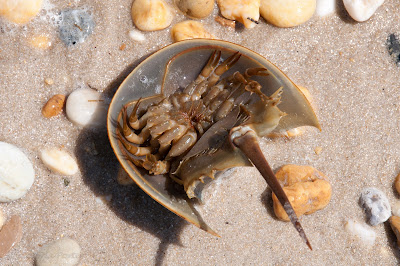In the
previous post, I included a picture of a crab pileup and quite a bit of information about the Horseshoe Crabs... this first image in today's post is of a breeding pair who are working their way to shore (although here, the waves seem to be carrying them out) so the female can lay the eggs (she's the front, larger one) and the male can then fertilize them. The female pulls him along behind her so he can do his part after she finishes laying the eggs.

This is a young Horseshoe Crab before it has developed the front claws which allow us to know whether it is male or female. Males have front claws shaped roughly like boxing gloves, the better to grip onto the rear of the female's shell as seen in the previous image. When a Horseshoe Crab gets turned upside down, it uses its long, spiny tail to flip itself upright. We assisted this one in righting itself at which point it headed for the water. When upside down, the crab is extremely vulnerable to predators. Also, its gills will dry out quite rapidly which means it will certainly die unless it rights itself and returns to the bay.
This is the same young crab, heading for the water after we turned it back upright to assist it. You can certainly see why they are referred to as living fossils... and they have been around since prehistoric time.
Sanderlings on the beach... a possible caption for this is "you go this way and I'll go the other way" as they search for crab eggs and/or the tiny creatures deposited as the waves recede from the shore.
I think this is an immature Herring Gull but am not certain. I'll have to do more research but it's almost 1:00 AM and time for bed so I want to wrap up this post soon!
The oddly shaped "rock" in the center of this image isn't a rock at all... it is a Sea Cucumber! It was spotted by one of our group and we weren't at all certain what it was. Our naturalist guide told us a bit about these strange creatures, most of which I've forgotten already. The one thing that stuck in my mind is that when it feels threatened, it will puff itself up and expel its stomach. A predator will then eat the stomach instead of the Sea Cucumber and the "cuke" will go merrily on its way and simply grow a new stomach.












No comments:
Post a Comment